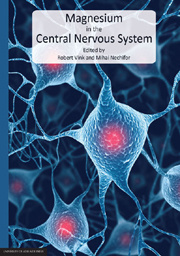Book contents
- Frontmatter
- List of Contributors
- Preface
- Contents
- Section 1 Magnesium in Normal Brain
- Chapter 1 Free magnesium concentration in human brain
- Chapter 2 Intracellular magnesium homeostasis
- Chapter 3 Magnesium transport across the blood-brain barriers
- Chapter 4 Intracellular free Mg2+ and MgATP2− in coordinate control of protein synthesis and cell proliferation
- Chapter 5 Magnesium and the Yin-Yang interplay in apoptosis
- Chapter 6 Brain magnesium homeostasis as a target for reducing cognitive ageing
- Section 2 Magnesium in Neurological Diseases
- Section 3 Involvement of Magnesium in Psychiatric Diseases
Chapter 4 - Intracellular free Mg2+ and MgATP2− in coordinate control of protein synthesis and cell proliferation
from Section 1 - Magnesium in Normal Brain
Published online by Cambridge University Press: 05 June 2012
- Frontmatter
- List of Contributors
- Preface
- Contents
- Section 1 Magnesium in Normal Brain
- Chapter 1 Free magnesium concentration in human brain
- Chapter 2 Intracellular magnesium homeostasis
- Chapter 3 Magnesium transport across the blood-brain barriers
- Chapter 4 Intracellular free Mg2+ and MgATP2− in coordinate control of protein synthesis and cell proliferation
- Chapter 5 Magnesium and the Yin-Yang interplay in apoptosis
- Chapter 6 Brain magnesium homeostasis as a target for reducing cognitive ageing
- Section 2 Magnesium in Neurological Diseases
- Section 3 Involvement of Magnesium in Psychiatric Diseases
Summary
Abstract
Specific and non-specific mitogens stimulate the proliferation of cultured fibroblasts. They also stimulate other responses that are part of a coordinate response, some members of which are essential for proliferation and others that are not. The synthesis of protein is an early response to mitogens and its continuation through the G1 period drives the accumulation of protein which is required for the initiation of DNA synthesis hours later. The parabola-like curve for dependence of protein synthesis on intracellular Mg2+ concentration is similar to that of cell-free ribosome preparations, and is later reflected in the initiation of DNA synthesis. Hence, DNA synthesis is dependent on the rate of protein synthesis which is regulated by the concentration of intracellular Mg2+. Presumably free Mg2+ is an indicator of the fraction of ATP4− that is complexed with Mg2+ as MgATP2−, which is the immediate regulatory form. Uridine uptake is determined by its phosphorylation which is also dependent on intracellular Mg2+ in the coordinate response, but unlike protein synthesis, neither influences DNA synthesis nor exhibits downturn at a high Mg2+ concentration. Intracellular free Mg2+ determines the onset of protein synthesis in activated frog oocytes and its rate in lymphocytes. Mg2+ regulation of protein synthesis is effected through the PI 3-K pathway at mTOR phosphorylation of two translation-regulating proteins. Regulation of proliferation by Mg2+ is lost in transformed cells. Mg2+ and MgATP2− apparently play a central role in the regulation of metabolism in a wide variety of cells and developmental stages across the animal kingdom.
- Type
- Chapter
- Information
- Magnesium in the Central Nervous System , pp. 75 - 84Publisher: The University of Adelaide PressPrint publication year: 2011
- 3
- Cited by



